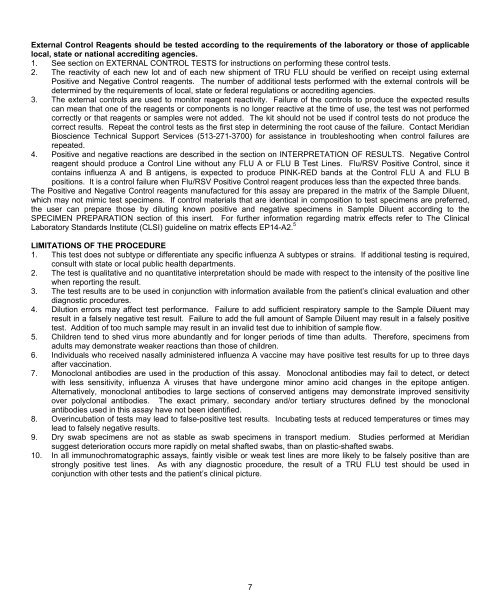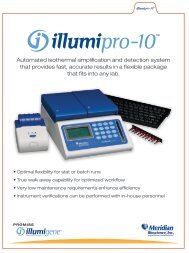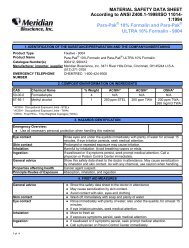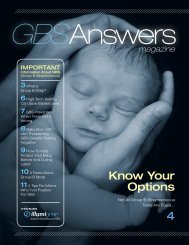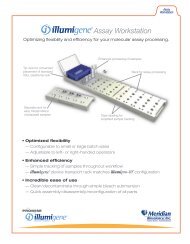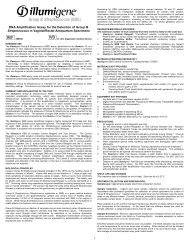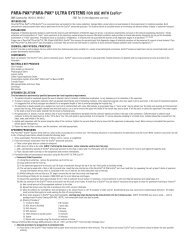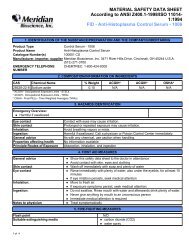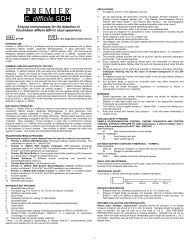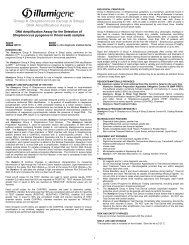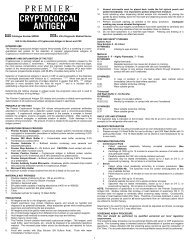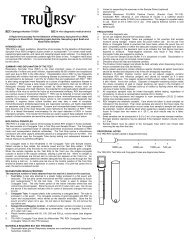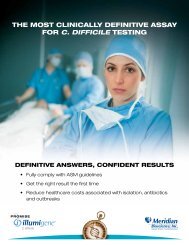1 (US Patent No. US D560281 (S1); US D5601344 (S1); US ...
1 (US Patent No. US D560281 (S1); US D5601344 (S1); US ...
1 (US Patent No. US D560281 (S1); US D5601344 (S1); US ...
You also want an ePaper? Increase the reach of your titles
YUMPU automatically turns print PDFs into web optimized ePapers that Google loves.
External Control Reagents should be tested according to the requirements of the laboratory or those of applicable<br />
local, state or national accrediting agencies.<br />
1. See section on EXTERNAL CONTROL TESTS for instructions on performing these control tests.<br />
2. The reactivity of each new lot and of each new shipment of TRU FLU should be verified on receipt using external<br />
Positive and Negative Control reagents. The number of additional tests performed with the external controls will be<br />
determined by the requirements of local, state or federal regulations or accrediting agencies.<br />
3. The external controls are used to monitor reagent reactivity. Failure of the controls to produce the expected results<br />
can mean that one of the reagents or components is no longer reactive at the time of use, the test was not performed<br />
correctly or that reagents or samples were not added. The kit should not be used if control tests do not produce the<br />
correct results. Repeat the control tests as the first step in determining the root cause of the failure. Contact Meridian<br />
Bioscience Technical Support Services (513-271-3700) for assistance in troubleshooting when control failures are<br />
repeated.<br />
4. Positive and negative reactions are described in the section on INTERPRETATION OF RESULTS. Negative Control<br />
reagent should produce a Control Line without any FLU A or FLU B Test Lines. Flu/RSV Positive Control, since it<br />
contains influenza A and B antigens, is expected to produce PINK-RED bands at the Control FLU A and FLU B<br />
positions. It is a control failure when Flu/RSV Positive Control reagent produces less than the expected three bands.<br />
The Positive and Negative Control reagents manufactured for this assay are prepared in the matrix of the Sample Diluent,<br />
which may not mimic test specimens. If control materials that are identical in composition to test specimens are preferred,<br />
the user can prepare those by diluting known positive and negative specimens in Sample Diluent according to the<br />
SPECIMEN PREPARATION section of this insert. For further information regarding matrix effects refer to The Clinical<br />
Laboratory Standards Institute (CLSI) guideline on matrix effects EP14-A2. 5<br />
LIMITATIONS OF THE PROCEDURE<br />
1. This test does not subtype or differentiate any specific influenza A subtypes or strains. If additional testing is required,<br />
consult with state or local public health departments.<br />
2. The test is qualitative and no quantitative interpretation should be made with respect to the intensity of the positive line<br />
when reporting the result.<br />
3. The test results are to be used in conjunction with information available from the patient’s clinical evaluation and other<br />
diagnostic procedures.<br />
4. Dilution errors may affect test performance. Failure to add sufficient respiratory sample to the Sample Diluent may<br />
result in a falsely negative test result. Failure to add the full amount of Sample Diluent may result in a falsely positive<br />
test. Addition of too much sample may result in an invalid test due to inhibition of sample flow.<br />
5. Children tend to shed virus more abundantly and for longer periods of time than adults. Therefore, specimens from<br />
adults may demonstrate weaker reactions than those of children.<br />
6. Individuals who received nasally administered influenza A vaccine may have positive test results for up to three days<br />
after vaccination.<br />
7. Monoclonal antibodies are used in the production of this assay. Monoclonal antibodies may fail to detect, or detect<br />
with less sensitivity, influenza A viruses that have undergone minor amino acid changes in the epitope antigen.<br />
Alternatively, monoclonal antibodies to large sections of conserved antigens may demonstrate improved sensitivity<br />
over polyclonal antibodies. The exact primary, secondary and/or tertiary structures defined by the monoclonal<br />
antibodies used in this assay have not been identified.<br />
8. Overincubation of tests may lead to false-positive test results. Incubating tests at reduced temperatures or times may<br />
lead to falsely negative results.<br />
9. Dry swab specimens are not as stable as swab specimens in transport medium. Studies performed at Meridian<br />
suggest deterioration occurs more rapidly on metal shafted swabs, than on plastic-shafted swabs.<br />
10. In all immunochromatographic assays, faintly visible or weak test lines are more likely to be falsely positive than are<br />
strongly positive test lines. As with any diagnostic procedure, the result of a TRU FLU test should be used in<br />
conjunction with other tests and the patient’s clinical picture.<br />
7


